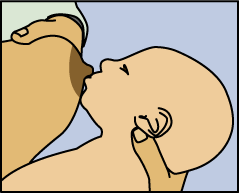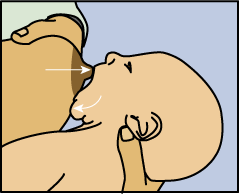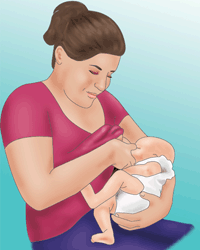Breastfeeding: Best for baby. Best for mom.
 Learning to Breastfeed Learning to Breastfeed
Home > Breastfeeding Home > Learning to Breastfeed
How Breast Milk Is Made
Knowing how the breast is made and how it works to produce milk can help you understand the breastfeeding process. The breast itself is a gland that is composed of several parts, including glandular tissue, connective tissue, blood, lymph, nerves, and fatty tissue. Fatty tissue is what mostly affects the size of a woman's breast. Breast size does not have an effect on the amount of milk or the quality of milk a woman makes.
Special cells inside your breasts make milk. These cells are called alveoli (al-VEE-uh-leye). When your breasts become fuller and tender during pregnancy, this is a sign that the alveoli are getting ready to work. Some women do not feel these changes in their breasts. Some women experience breast changes after their baby is born. If you have a question about your breast changes, you can ask your doctor or a lactation consultant.

The alveoli make milk in response to the hormone prolactin, which rises when the baby suckles. Another hormone, oxytocin (oks-ee-TOH-suhn), causes these small muscles around the cells to contract and move the milk through a series of small tubes called milk ducts. The milk ducts are located underneath the nipple and areola (air-ee-OH-luh), which is the darker skin that circles your nipple. Oxytocin also contracts the muscle of the uterus during and after birth. This helps the uterus to get back to its original size and lessens any bleeding a woman may have after giving birth. The release of both prolactin and oxytocin may be responsible in part for a mother's intense feeling of needing to be with her baby.
Babies Know How to Latch and Feed
Did you know that an alert, healthy newborn infant can latch on to the mother's breast with little or no help? Babies are born knowing how to find the breast and suckle all by themselves. All they need is a chance to practice. The more milk your baby removes from the breasts the more milk you will make. Immediately after birth, ask the hospital to delay unnecessary procedures, if possible, and to allow you and your partner some quiet time to snuggle with your baby during the first hour or two.
Learning to "dance":
- Learning to breastfeed is like learning to dance. It is best to wait until you and your baby are calm. Hold your baby, wearing only a diaper, skin-to-your-skin up against your bare chest and upright with his or her head under your chin. Your baby will be comfortable in that cozy valley between your breasts. You can ask your partner or a nurse to place a blanket across your baby's back and bring your bedcovers over you both. Your skin temperature will rise to warm your baby.
- Softly talk to your baby and massage him or her with gentle strokes.
- When awake, your baby will move his or her head back and forth, looking and feeling for the breast with his or her mouth and lips. Your baby might even look up at you and make eye contact. This is an important time for your baby to learn that you are his or her mother, so enjoy this special time by talking or singing softly to your baby.
- Support his or her neck and shoulders with one hand and hips with the other as he or she twists and turns in an effort to find your breast.
You can help as your baby looks for your breast:
- Support your baby with your arms so that you both are comfortable.
- Allow your breast to hang naturally and, when your baby feels it with his or her cheek, he or she will open his mouth wide and reach it up and over the nipple.
- Your baby's head should be tilted back slightly to make it easy to suck and swallow. With his or her head back and mouth open, the tongue is naturally down and ready for the breast to go on top of it.
- You will see that, at first, your baby's nose is lined up opposite your nipple. As his or her chin presses into your breast, his or her wide, open mouth will get a large mouthful of breast for a deep latch.
- Allow your baby's arms to hug your breast.
- Do not put your hands on your baby's head. As it tilts back, you can support your baby's upper back and shoulders with the palm of your hand and pull your baby in close.
Practice makes perfect:
- During the early days and weeks during breastfeeding, you and your baby are both learning how to breastfeed. Take your time and be patient. Breastfeed as often and as long as your baby wants. Soon you will both be experts!
- As your baby gets older, you will be able to hold your baby close to you at your breast with his or her mouth at your nipple and your baby will latch on easily.
- What works well for one feeding might not work well at the next. Try different positions until you find one that works for both of you.
If your baby has trouble latching:

1. Tickle baby's lips to encourage him to open wide. |

2. Pull your baby close so that the chin and lower jaw moves into your breast first. |

3. Watch the lower lip and aim it as far from base of nipple as possible, so the baby takes a large mouthful of breast. |
|
|
What if...
You have pain? – Many moms report that their breasts can be tender at first until both they and their baby find comfortable breastfeeding positions and a good latch. Once you have done this, breastfeeding should be comfortable. If it hurts, your baby may be sucking on only the nipple. Gently break your baby's suction to your breast by placing a clean finger in the corner of your baby's mouth and try again. Your nipple also should not look flat or compressed when it comes out of your baby's mouth. It should look round and long, or the same shape as it was before the feeding.
You or your baby are frustrated? – Take a short break and hold your baby in an upright position. Consider holding him or her skin-to-your-skin. Talk, sing, or provide your finger for sucking for comfort. Try to breastfeed again in a little while.
Your baby has a weak suck, or makes only tiny suckling movements? – Break your baby's suction and try again. He or she may not have a deep enough latch to remove the milk from your breast. Talk with a lactation consultant if your baby's suck feels weak or if you are not sure he or she is getting a good feeding of milk. Your baby might have a health problem that is causing the weak suck.
You have other concerns? – Contact a lactation consultant, peer counselor, breastfeeding-trained doula, or your doctor for help.
Signs of a Good Latch
 |
A good latch-on is important for your baby to breastfeed effectively and for your comfort. During the early days and weeks during breastfeeding, it can take time and patience for your baby to latch on well. |
|
|
- How it feels is more important than how it looks. The latch feels comfortable to you, without hurting or pinching.
- Your baby's chest is against your body and he or she does not have to turn his or her head while drinking.
- You see little or no areola, depending on the size of your areola and the size of your baby's mouth. If areola is showing, you will see more above your baby's lip and less below.
- When your baby is positioned well, his or her mouth will be filled with breast.
- The tongue is cupped under the breast, although you might not see it.
- You hear or see your baby swallow. Some babies swallow so quietly, a pause in their breathing may be the only sign of swallowing.
- You see the baby's ears "wiggle" slightly.
- Your baby's lips turn out like fish lips, not in. You may not even be able to see the bottom lip.
- Your baby's chin touches your breast.
Breastfeeding Holds
Some moms find that the following positions are also helpful ways to get comfortable and support their babies in finding a good latch. You also can use pillows under your arms, elbows, neck, or back to give you added comfort and support.
 1. Cradle hold – an easy, common hold that is comfortable for most mothers and babies. Hold your baby with his or her head on your forearm and his or her whole body facing yours. 1. Cradle hold – an easy, common hold that is comfortable for most mothers and babies. Hold your baby with his or her head on your forearm and his or her whole body facing yours.
 2. Cross cradle or transitional hold – useful for premature babies or babies with a weak suck because it gives extra head support and may help babies stay latched. Hold your baby along the opposite arm from the breast you are using. Support your baby's head with the palm of your hand at the base of his or her neck. 2. Cross cradle or transitional hold – useful for premature babies or babies with a weak suck because it gives extra head support and may help babies stay latched. Hold your baby along the opposite arm from the breast you are using. Support your baby's head with the palm of your hand at the base of his or her neck.
 3. Clutch or "football" hold – useful for mothers with large breasts, flat or inverted nipples, overactive let-down, or who had a c-section. It is also helpful for babies who prefer to be more upright. This hold allows you to better see and control your baby's head and keeps the baby away from a c-section incision. Hold your baby at your side, lying on his or her back, with his or her head at the level of your nipple. Support baby's head with the palm of your hand at the base of the head. 3. Clutch or "football" hold – useful for mothers with large breasts, flat or inverted nipples, overactive let-down, or who had a c-section. It is also helpful for babies who prefer to be more upright. This hold allows you to better see and control your baby's head and keeps the baby away from a c-section incision. Hold your baby at your side, lying on his or her back, with his or her head at the level of your nipple. Support baby's head with the palm of your hand at the base of the head.
 4. Side-lying position – useful for mothers who had a c-section or to help any mother get some extra rest or sleep while the baby breastfeeds. This hold allows you to rest or sleep while your baby nurses. Lie on your side with your baby facing you. Pull your baby close so your baby faces your body. Follow important safety tips to lower the risk of sudden infant death syndrome (SIDS). 4. Side-lying position – useful for mothers who had a c-section or to help any mother get some extra rest or sleep while the baby breastfeeds. This hold allows you to rest or sleep while your baby nurses. Lie on your side with your baby facing you. Pull your baby close so your baby faces your body. Follow important safety tips to lower the risk of sudden infant death syndrome (SIDS).
Tips for Making It Work
| If you are still having problems breastfeeding after following these tips, it is important to get help from a lactation consultant or other breastfeeding support person. |
|
- Breastfeed early and often. Breastfeed as soon as possible after birth, within the first hour of life. If you had a vaginal birth you can hold your baby and breastfeed right away. If you had a c-section or general anesthesia after the birth for a surgery, tell your doctor and nurse that you want to breastfeed as soon as you are both in the recovery room.
- Breastfeed at least eight to 12 times every 24 hours to make plenty of milk for your baby.
- Keep your baby in your hospital room with you (also called "rooming in") so you can see your baby's first signs of being hungry. When babies are hungry they become more alert and active, may put their hands or fists to their mouths, make sucking motions with their mouth, or turn their heads looking for the breast. Crying is a late sign of hunger.
- Make sure you are both comfortable and follow your baby's lead after he or she is latched well onto the underside of the breast, not just the nipple. Some babies take both breasts at each feeding, while others only take one breast at a feeding. Help your baby finish the first breast, as long as he or she is still sucking and swallowing. Your baby will let go of the breast when he or she is finished, and often falls asleep. Offer the other breast if he or she seems to want more. Let your baby decide when to stop nursing.
- Keep your baby close to you. Remember that your baby is not used to this new world and needs to be held very close to his or her mother. Being skin-to-skin with you helps babies cry less and stabilizes the baby's heart and breathing rates.
- Avoid using pacifiers, bottles, and supplements of infant formula in the first few weeks unless there is a medical reason to. It's best just to breastfeed to get the milk process running smoothly and to keep your baby from getting confused while he or she is learning to breastfeed.
- Have your baby sleep in a crib or bassinet in your room, but not in your bed, so that you can breastfeed more easily at night.
Ways to wake your baby to breastfeed:
In the early weeks after birth, you should wake your baby to feed if four hours have passed since the beginning of the last feeding. You can:
- remove any blankets
- change your baby's diaper
- place your baby skin-to-skin
- massage your baby's back, abdomen, arms and legs
Making Plenty of Milk
Did you know?
Most mothers can make plenty of milk for their baby. If you are not sure if you are having a milk supply problem, talk to a lactation consultant. |
|
|
Your breasts will easily make and supply milk directly in response to your baby's needs. The more often and effectively a baby breastfeeds, the more milk will be made. Babies are trying to double their weight in a few short months, and their tummies are small, so they need many feedings to grow and to be healthy.
- You can expect at least eight to 12 feedings in a 24-hour day.
- In the first few days after birth, your baby will likely want to breastfeed about every hour or two in the daytime, and a couple of times at night during which your baby can have one longer sleep stretch.
- Babies develop their own feeding schedules. Some babies feed every hour for 2-6 hours and then sleep for a longer period, and others will breastfeed every 2-3 hours day and night. Follow your baby's cues for when he or she is ready to eat.
What will happen with you, your baby, and your milk in the first few weeks
| |
Milk |
The Baby |
You (Mom) |
| Birth |
Your body makes colostrum, a rich, thick, yellowish milk and in small amounts. It gives your baby a healthy dose of early protection against diseases. |
Will probably be awake in the first hour after birth and this is a good time to breastfeed your baby. |
You will be tired and excited. This is a good time to feed the baby. |
| First 12-24 hours |
Your baby will drink about 1 teaspoon of colostrum at each feeding. You may not see the colostrum, but it has what the baby needs and in the right amount. |
It is normal for the baby to sleep heavily. Labor and delivery are hard work for the baby. Some babies like to nuzzle and may be too sleepy to latch well at first. Feedings may be short and disorganized. As your baby wakes up, take advantage of your baby's strong instinct to suck and feed every 1-2 hours. Many babies like to eat or lick, pause, savor, doze, then eat again. Ask the nurse not to give your baby any formula or water unless you are informed first or for some reason your doctor has said the baby needs it. |
You will be tired too. Rest. |
| Next 3-5 days |
Your white milk comes in. It is normal for it to be yellow or golden at first. |
Your baby will feed a lot (this helps your breasts make plenty of milk), at least 8-12 times or more in 24 hours. Very young breastfed babies don't eat on a schedule. Since breast milk is more easily digested than formula, breastfed babies eat more often than formula-fed babies. It is okay if your baby eats every 2-3 hours for several hours, then sleeps for 3-4 hours. Expect feedings to take about 15-20 minutes on each side. The baby's sucking rhythm will be slow and long. You might hear gulping. |
Your breasts will feel full and leak. (You can use disposable or cloth pads in your bra to help with leaking.) |
| The first 4-6 weeks |
White breast milk. |
Your baby will likely be better at breastfeeding and have a larger stomach to hold more milk. Feedings may take less time and will be farther apart. |
Your body gets used to breastfeeding so your breasts will be softer and the leaking will slow down. |
How to Know Your Baby is Getting Enough Milk
Print a blank worksheet to keep track of wet diapers and bowel movements
 Diaper Checklist (PDF, 126 Kb) Diaper Checklist (PDF, 126 Kb) |
|
Many babies, but not all, lose a small amount of weight in the first days after birth. Your baby's health care provider will check his or her weight at your first visit after you leave the hospital. Make sure to visit your baby's health care provider within three to five days after birth and then again at two to three weeks of age for check-ups. You also can tell if your baby is getting plenty of milk by keeping track of the number of wet diapers and diapers with bowel movements.
Minimum number of wet diapers and bowel movements in a baby's first week
(it is fine if your baby has more)
1 day = 24 hours
| Baby's Age |
Number of Wet Diapers |
Number of Bowel Movements |
Color and Texture of Bowel Movements |
| Day 1 (first 24 hours after birth) |
1 |
The first one usually occurs within 8 hours after birth |
Thick, tarry and black |
| Day 2 |
2 |
3 |
Thick, tarry and black |
| Day 3 |
5-6 |
3 |
Looser greenish to yellow |
| Day 4 |
6 or more |
3 |
Yellow, soft and watery |
| Day 5 |
6 or more |
3 |
Loose seedy, yellow color |
| Day 6 |
6 or more |
3 |
Loose seedy, yellow color |
| Day 7 |
6 or more |
3 |
Larger amounts of loose seedy, yellow color |
Some babies will switch to less frequent but large bowel movements at about six weeks of age.
Source:International Lactation Consultant Association. Clinical Guidelines for the Establishment of Exclusive Breastfeeding. June 2005.
Other signs that your baby is getting plenty of milk
| Consult your baby's health care provider if you are concerned about your baby's weight gain. |
|
- Baby is mostly content and gaining weight steadily after the first week of age. From birth to three months, typical weight gain is 2/3 to 1 ounce each day.
- Baby is passing clear or pale yellow urine, not deep yellow or orange.
- Baby has at least three stools every 24 hours after day 1.
- Baby alternates short sleeping periods with wakeful, alert periods.
- Baby is satisfied and content after feedings.
- Your breasts feel softer after you feed your baby.
Sleeping Close to Baby
The American Academy of Pediatrics (AAP) recommends that for breastfed healthy term infants, mothers and infants should sleep close to each other to help with breastfeeding.
The AAP reports that a study1 that examined babies sleeping with parents and the risk of sudden infant death syndrome (SIDS) found:
- Co-sleeping with an infant on a sofa was associated with a particularly high risk of SIDS.
- Sharing a room with the parents was associated with a lower risk of SIDS.
- There was no increased risk associated with bed sharing when the infant was placed back in his or her cot.
- Among parents who do not smoke or infants older than 14 weeks there was no association between infants being found in the parental bed and an increased risk of SIDS.
- The risk linked with bed sharing among younger infants seems to be associated with recent parental consumption of alcohol, overcrowded housing conditions, extreme parental tiredness, and the infant being under a blanket.
1Blair PS, Fleming PJ, Smith IJ, et al. Babies sleeping with parents: case-control study of factors influencing the risk of the sudden infant death syndrome. BMJ. 1999; 319: 1457-1462.
Additional Resources
Publications
 Breast Milk — This publication contains information on breast milk. It explains why it is better than cow's milk for infants, how breast milk is produced, how to establish, maintain or increase your milk supply, and how to store breast milk.
Breast Milk — This publication contains information on breast milk. It explains why it is better than cow's milk for infants, how breast milk is produced, how to establish, maintain or increase your milk supply, and how to store breast milk. http://www.nlm.nih.gov/medlineplus/ency/article/002451.htm
Breastfeeding 101 (Copyright © ACNM) — This publication outlines the basic steps moms need to take when preparing to breastfeed, as well as issues they may face regarding siblings of the new baby and how to develop family support. http://www.mymidwife.org/breastfeeding.cfm
Breast Feeding: Hints to Help You Get Off to a Good Start (Copyright © AAFP) — This fact sheet offers helpful hints on successful breastfeeding including the benefits, how to hold your baby, the let-down reflex, preventing and healing sore nipples, signs that your baby is getting enough milk, what to avoid eating and where to get more information on breastfeeding. http://familydoctor.org/online/famdocen/home/women/pregnancy/birth/019.html
Breastfeeding the High-Risk Newborn (Copyright © UUHSC) — This on-line resource offers information on the benefits of breastfeeding high risk newborns including how to overcome difficulties in breastfeeding, how to express breast milk, and how to maintain milk production. http://www.uuhsc.utah.edu/healthinfo/pediatric/Hrnewborn/bresthub.htm
Breastfeeding Tips (Copyright © NMC, INC.) — This on-line resource gives breastfeeding tips on establishing a good milk supply, positioning, engorgement, sore nipples, and signs that breastfeeding is going well. http://www.nursingmothers.org/tips.htm
Breastfeeding vs. Formula Feeding (Copyright © Kids Health) — This publication contains information on the benefits of breastfeeding, the pros and cons of bottle-feeding, instructions on how to breastfeed or bottle-feed your baby, as well as answers to common breastfeeding questions. http://www.kidshealth.org/parent/food/infants/breast_bottle_feeding.html
Breastfeeding Your Baby (Copyright © ACOG) — This on-line resource about breastfeeding contains information on the benefits, facts, getting started, how to breastfeed, diet, sex and birth control, work, and breast health. It also includes a glossary of terms. http://www.acog.org/publications/patient_education/bp029.cfm
Effective Sucking (Copyright © UUHSC) — This on-line fact sheet has information pertaining to breastfeeding and effective sucking. It explains what a mother should listen for during feeding and how long the newborn should nurse before self-detachment. http://www.uuhsc.utah.edu/healthinfo/adult/Pregnant/bfsuckng.htm
FAQ on Breastfeeding Twins (Copyright © LLLI) — This publication provides information on breastfeeding twins. It includes positioning techniques, feeding plans, and ways to care for oneself. http://www.llli.org/FAQ/twins.html
Got Mom... (Copyright © ACNM) — GotMom.org was created by the American College of Nurse-Midwives to provide breastfeeding information and resources for mothers and families. It contains information on why breast milk is best, dispels common misunderstandings about breastfeeding, and it provides a list of resources that can help women and families with breastfeeding.
How Can I Increase My Milk Supply? (Copyright © La Leche League International) — This publication explains how to know if you're not producing enough breast milk for your baby and gives tips on increasing your milk supply. http://www.lalecheleague.org/FAQ/increase.html
How Can I Tell if My Baby is Getting Enough Milk? (Copyright © La Leche League International) — This publication explains how to look for signs that your baby is getting enough breast milk. It also provides additional resources on milk supply and breastfeeding for more information. http://www.lalecheleague.org/FAQ/enough.html
How Do I Wean My Baby? (Copyright © LLLI) — This publication explains why it is important to wean your baby slowly off of the breast. It also gives tips for when and how to reduce feedings to make the weaning process easier. http://www.lalecheleague.org/FAQ/weanhowto.html
How Often Should I Nurse My Baby? (Copyright © LLLI) — This publication gives guidelines for how often babies should breastfeed. It also explains why a baby may feed frequently or infrequently and what behaviors are considered normal during the period of breastfeeding. http://www.lalecheleague.org/FAQ/frequency.html
Increasing Breastfeeding Success: Why it Matters and What the Research Shows (Copyright © Breastfeeding Coalition of Washington) — This publication is a set of ten lactation presentations designed to educate physicians and their staff in the in-patient or out-patient setting. http://www.breastfeedingwa.org/node/116
Preparing My Breasts to Breastfeed (Copyright © LLLI) — This publication contains information on what you need to do to prepare to breastfeed and possible challenges that you might face while breastfeeding. http://www.llli.org/FAQ/breastprep.html
Weaning Your Child (Copyright © The Nemours Foundation) — This publication discusses when to wean and also gives tips on how to start weaning to make the transition easier. http://www.kidshealth.org/parent/pregnancy_newborn/feeding/weaning.html
Organizations
-
 Maternal and Child Health Bureau, HRSA, HHS
Maternal and Child Health Bureau, HRSA, HHS
-
 National Center for Education in Maternal and Child Health, MCHB, HRSA, HHS
National Center for Education in Maternal and Child Health, MCHB, HRSA, HHS
-
 Womenshealth.gov, OWH, HHS
Womenshealth.gov, OWH, HHS
-
American Academy of Pediatrics
-
American College of Nurse-Midwives
-
Familydoctor.org
-
International Lactation Consultant Association (ILCA)
-
La Leche League International
-
National Healthy Mothers, Healthy Babies Coalition
-
Wellstart International
-
World Alliance For Breastfeeding Action
 = Indicates Federal Resources = Indicates Federal Resources
Content last updated February 27, 2009.
|
![]() You may need to download a free PDF reader to view files marked with this icon.
You may need to download a free PDF reader to view files marked with this icon.